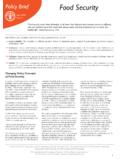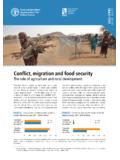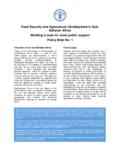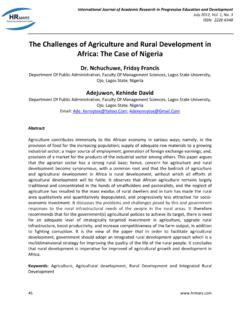Transcription of Mobile Applications for Agriculture and Rural …
1 Mobile Applications for Agriculture and Rural development Christine Zhenwei Qiang, Siou Chew Kuek*, Andrew Dymond and Steve Esselaar ICT Sector Unit World Bank December 2011 This report is the product of the staff and consultants of the World Bank. The findings, interpretations, and conclusions do not necessarily reflect the views of the Executive Directors of the World Bank or the governments they represent. The World Bank does not guarantee the accuracy of the data included in this work. * Corresponding author: 1818 H Street NW, MSN MC6-616, Washington DC 20433, USA. Contents Executive Summary .. i 1. Introduction .. 1 What Are Mobile Applications ?.
2 1 This Report s Scope, Audience, and Focus .. 5 2. Methodology and Case 7 Typology .. 7 Case Studies .. 8 3. development Impact .. 14 Quantitative Impact .. 17 Qualitative Impact .. 25 4. Mobile Ecosystems .. 26 Key Players .. 27 30 Highly Local Content and Services .. 33 5. Business Models .. 35 36 Willingness to Pay .. 38 39 Typical revenue streams .. 39 Alternative revenue streams .. 41 Pricing Models .. 43 Nonchargeable model .. 44 Transactional model .. 44 Embedded services model .. 44 Freemium model .. 44 Costs .. 45 48 Different funding issues for commercial and noncommercial Mobile Applications .. 50 Financing forms, types, and cycles .. 51 Possible financing solutions .. 52 6. Conclusion.
3 57 Annex A: Typology of Agricultural and Rural development .. 60 Annex B: Information Sheet Used for Desk Research on Mobile Applications .. 62 Annex C: Types of Mobile Applications by Subsector .. 63 Annex D: Mobile Applications Ecosystem for Agricultural and Rural development .. 93 Annex E: Summary of Lessons by Subsector .. 97 Annex F: Detailed Case Study Information Sheets .. 103 Annex G: Kenya Case Study .. 103 Annex H: Philippines Case Study .. 103 Annex I: Sri Lanka Case Study .. 103 References .. 104 Abbreviations 2G Second generation ( Mobile communications) 3G Third generation ( Mobile communications) 4G Fourth generation ( Mobile communications) API Application Programming Interface B2B Business to Business CSR Corporate Social Responsibility DFID Department for International development EDGE Enhanced Data rates for GSM Evolution FMCG Fast Moving Consumer Goods GGS Govi Gnana Seva ICT Information and Communication Technology ICTA Information and Communication Technology Agency IFC International Finance Corporation IKSL IFFCO Kisan Sanchar Ltd KACE Kenya Agriculture Commodities Exchange KTDA Kenya Tea Production Authority LTE 3 GPP Long Term Evolution m-apps Mobile Applications m-ARD apps Mobile Applications for Agriculture and Rural development m-money Mobile Money NGO Nongovernmental Organization NHS National Healthcare System OECD
4 Organisation for Economic Co-operation and development OLT Ovi Life Tools PE/VC Private Equity/Venture Capital PPP Private-Public Partnership PWC PricewaterhouseCoopers RFP Request for Proposal RML Reuters Market Light SME Small and medium-size Enterprise SMS Short Message Service SWORB Strengths, Weakness, Opportunities, Risks, Benefits TOR Terms of Reference USF Universal Service Fund USSD Unstructured Supplementary Service Data Page i Executive Summary Mobile communications technology has quickly become the world s most common way of transmitting voice, data, and services in the developing world. Given this dramatic change, Mobile Applications (m-apps) in general and Mobile Applications for agricultural and Rural development (m-ARD apps) in particular hold significant potential for advancing development .
5 They could provide the most affordable ways for millions of people to access information, markets, finance, and governance systems previously unavailable to them. M-apps are software designed to take advantage of Mobile technology and can be developed for technology besides Mobile phones. But Mobile phones have many key advantages: affordability, wide ownership, voice communications, and instant and convenient service delivery. As a result, there has been a global explosion in the number of m-apps, facilitated by the rapid evolution of Mobile networks and by the increasing functions and falling prices of Mobile handsets. M-apps are markedly different in developing countries because they typically run on second-generation (2G) phones rather than smartphones, which are far more common in developed countries.
6 Though there have been many studies on the Mobile revolution, there is a lack of systematic trend analyses, in-depth case studies, and assessments of experiences with m-ARD apps in developing countries. Thus this report examines their development impact, ecosystems, and business models to provide an analytical framework for policymakers and development practitioners. The framework is designed to help them understand how these Applications can be used to improve services for Rural residents in these countries and support enabling environments for innovative m-ARD apps. The report summarizes a study of 92 m-ARD apps in Africa, Asia, and Latin America and the Caribbean (Annex F; detailed information sheets for each app are available at ).
7 It also presents the findings of 15 detailed case studies of such apps in Kenya, the Philippines, and Sri Lanka (Annexes G, H, and I). This type of report faces several challenges. M-apps are evolving rapidly, with innovative new ones entering the market daily and several large institutional players such as Mobile network operators competing for market share. Moreover, m-ARD apps are relatively new, and many have not been around long enough to properly assess their success. development Impact Most m-ARD apps focus on improving Agriculture supply chain integration and have a wide range of functions, such as providing market information, increasing access to extension services, and facilitating market links.
8 Users are also diverse, including farmers, produce buyers, cooperatives, input suppliers, content providers, and other stakeholders who demand useful, Page ii affordable services. These supply chain integration Applications could provide significant economic and social benefits among them, creating jobs, adding value, reducing product losses, and making developing countries more globally competitive. But the potential development impact of m-ARD apps mainly lies in their ability to provide access to useful, relevant information and services (Figure 1). Figure 1. Results Generated by Mobile Applications for Agricultural and Rural development Quantitatively, the most widely used m-ARD apps provide access to valuable information a crucial function because asymmetrical access to information is a weakness of Rural markets in developing countries.
9 Kenyan farmers who use the app DrumNet, for example, have seen their incomes rise by a third due to the service s comprehensive system of price negotiation, contracting, and other value chain support. Better access to information Better access to extension services Better market links and distribution networks Better access to finance Market information Climate and disease information Good agricultural practices Extension services Direct links between farmers, suppliers, and buyers Better recording, accounting, and traceability Credit Insurance Payment methods Higher prices, produce in greater demand Increased efficiency and predictability Higher-yield production More accurate assessments of pasture health Less exploitation by middlemen Better disaster and risk management Reduced administrative costs Reduced fraud Higher yields, more diverse production.
10 Fewer losses Higher incomes for small farmers Lower transaction, logistical, and distribution costs for input suppliers Improved traceability and quality standards for buyers New opportunities for financial institutions More efficient distribution chains Page iii M-ARD apps also provide farmers and Rural residents with timely access to extension services, such as advice on agricultural production, marketing, and technology, food security, and nutrition. Sri Lanka s e-Dairy helps farmers earn up to $262 more a year for each of their calves by providing veterinary and extension services delivered by Mobile phones. Such Applications also strengthen market links when used to improve production distribution and traceability.















